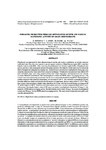| dc.description.abstract | Polyphenols are important for their pharmacological activity and positive contribution to cellular processes within the body. They have the capacity to protect against oxidation of High Density Lipids (HDL) and, thus help the body to retain HDL, while removing the problematic Low Density Lipids (LDL). Polyphenols also possess anti-ulcer, anti-carcinogenic and anti-mutagenic activities. The objective of this study was to evaluate the effect of temperature and grain size of grape seed on the efficiency of extraction of polyphenols from grape seed, using the compressed hot water and solvent extraction techniques. Polyphenols were extracted from milled (<0.5 mm) and whole grape seed, using compressed hot water (high temperature and high pressure) and solvents (Acetone, Methanol and Ethanol). The total polyphenol content and DPPH radical scavenging activity of the extracts were determined using spectrometer and the active compounds identified using HPLC. Total polyphenol content increased with extraction temperature, but decreased at 200 oC. The difference in polyphenol extracts from the milled and whole seed decreased with increase in temperature, but was more evident at 135 oC. The 2 hour extracts showed relatively higher values than those for 1 hour, with the lowest difference occurring at 165 oC and the highest at 180 oC. Solvent extracts from whole seeds were very low compared with the milled seeds, with acetone showing the highest value of 105 mg g-1 dry matter for polyphenol content and 110 mg g-1 of dry matter for DPPH radical scavenging activity. Methanol had the lowest value (78 mg g-1 dry matter) for polyphenol extracts and 80 mg g-1 for the DPPH radical scavenging activity. The main extract compounds were gallic acid, catechin and epicatechin | en_US |

